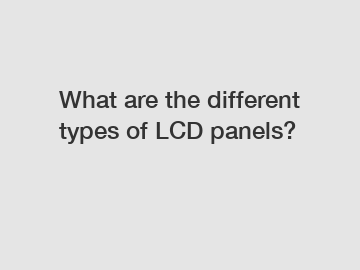What are the different types of LCD panels?
In today's technology-driven world, LCD (Liquid Crystal Display) panels have become an integral part of our lives, essentially serving as the visual gateway to various electronic devices. From televisions and computer monitors to smartphones and digital signage, these sleek and vibrant displays have revolutionized the way we consume visual content. But have you ever wondered about the different types of LCD panels that exist in the market? In this blog, we dive deep into the fascinating world of LCD technology to explore the myriad types and their unique characteristics.
1. TN (Twisted Nematic) Panels:
Let's begin with the most prevalent type of LCD panel – Twisted Nematic panels, commonly known as TN panels. TN panels are known for their affordability and high refresh rates, making them popular choices for gaming monitors. However, their downside includes limited viewing angles and relatively poorer color reproduction compared to other LCD types. Regardless, TN panels continue to dominate the entry-level market.

2. VA (Vertical Alignment) Panels:
Vertical Alignment panels, or VA panels, are widely renowned for their enhanced contrasts and superior color reproduction compared to TN panels. These panels offer wider viewing angles and deeper black levels, resulting in improved image quality. VA panels strike a balance between affordability and visual performance, making them a popular choice for home entertainment systems and high-end gaming monitors.
3. IPS (In-Plane Switching) Panels:
IPS panels are highly regarded for their impeccable color reproduction, wider viewing angles, and accurate color consistency across the screen. These panels are known for their vibrant and true-to-life visuals, making them ideal for professional photo and video editing, graphic design, and tasks that demand color accuracy. Although IPS panels often come with a higher price tag, their exceptional performance makes them worth the investment for enthusiasts and professionals alike.
4. S-IPS (Super In-Plane Switching) Panels:
Building upon the foundation of IPS technology, S-IPS panels further enhance color consistency, viewing angles, and response times. These panels deliver excellent color accuracy and are commonly found in high-end monitors that cater to demanding professional needs. However, due to their premium features, S-IPS panels can be relatively more expensive compared to traditional IPS panels.
5. OLED (Organic Light Emitting Diode) Panels:
While technically not an LCD technology, OLED panels warrant a mention due to their rising popularity and unique characteristics. OLED panels employ organic compounds that emit light when an electric current passes through them, eliminating the need for backlighting. This results in true blacks, infinite contrast ratios, and a wider color gamut. OLED panels are widely used in smartphones, televisions, and high-end portable devices, delivering stunning visuals with unparalleled color vibrancy and contrast.
Conclusion:
LCD panels come in various types, each designed to suit different usage scenarios and cater to specific needs. From the affordability and high refresh rates of TN panels to the exceptional color accuracy and wide viewing angles of IPS panels, it's crucial to understand the distinct features offered by different LCD technologies before making a purchase. Take into consideration your requirements, whether you value color accuracy, contrast ratios, gaming performance, or a balance of all attributes. By considering these factors, you will be well-equipped to choose the perfect LCD panel that meets your specific needs, enhancing your visual experience to new heights.
Contact us to discuss your requirements of Fuel Dispenser Liquid Crystal Module Manufacturer, ac lcd display, Segment Code LCD for Water Meter Panel. Our experienced sales team can help you identify the options that best suit your needs.
224
0
0

Comments
All Comments (0)